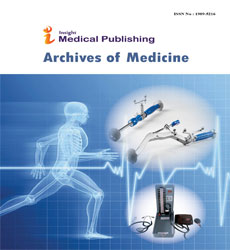Abstract
Influence of PatientÃÆâÃâââ¬Ãâââ¢s Exercise Tolerance on Exercise Heart Rate in Closed Loop Stimulation vs. Accelerometer-based Rate Adaptive Pacing
Background: In an earlier study comparing acceleration sensor (AS)- and closed loop stimulation (CLS)-based rateadaptive pacing, a sub analysis showed that heart rate (HR) after 6-minute walk (6MW) was higher in symptomatic (NYHA II/III) than symptom-free (NYHA I) patients in the CLS group only. The present study evaluated prospectively whether CLS unlike AS is able to differentiate between symptomatic and symptom-free patients, for whom 6MW represents demanding exercise versus low-to-moderate exercise, requiring marked versus moderate HR increase, respectively.
Methods: The study randomized 205 chronotropically incompetent patients 1:1 to AS or CLS. Primary endpoint was HR after 6MW for symptomatic versus symptom-free patients in each randomization group. A subanalysis tested primary endpoint only in patients with heart failure (HF). Secondary endpoint was HF progression over 2 years.
Results: The primary endpoint showed the expected tendency without statistical significance. In the subanalysis, HR after 6MW was significantly higher in symptomatic than symptom-free patients for CLS sensor (median, 92 vs. 84 bpm [P=0.021]), with an opposite non-significant trend for AS. HF development did not differ significantly between AS and CLS.
Conclusions: CLS increased HR more selectively than AS in symptomatic patients with HF. Progression of HF over 2 years was minimal in both modes.
Author(s):
Norbert Klein, Dietrich Pfeiffer, Dirk Stockman, Martin Hinterseer, Maximo Rivero-Ayerza, Maika Klein
Abstract | Full-Text | PDF
Share this

Archives of Medicine peer review process verified at publons
Abstracted/Indexed in
- Google Scholar
- Genamics JournalSeek
- China National Knowledge Infrastructure (CNKI)
- Directory of Research Journal Indexing (DRJI)
- WorldCat
- Proquest Summons
- Publons
- Geneva Foundation for Medical Education and Research
- Secret Search Engine Labs
- Euro Pub
Open Access Journals
- Aquaculture & Veterinary Science
- Chemistry & Chemical Sciences
- Clinical Sciences
- Engineering
- General Science
- Genetics & Molecular Biology
- Health Care & Nursing
- Immunology & Microbiology
- Materials Science
- Mathematics & Physics
- Medical Sciences
- Neurology & Psychiatry
- Oncology & Cancer Science
- Pharmaceutical Sciences


